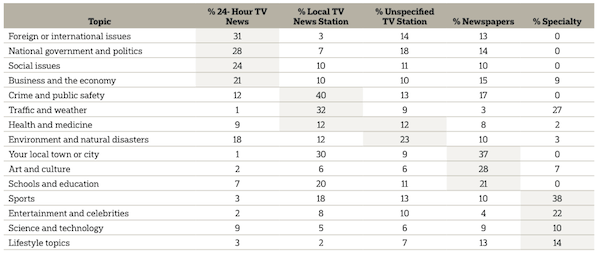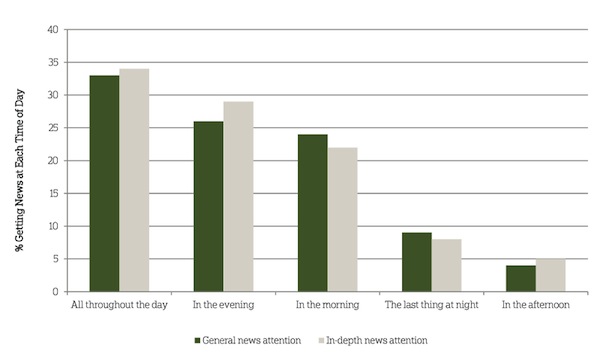
When it comes to finding and consuming news, Americans are only as faithful as their options.
A new report finds that how we consume the news is largely dependent on what we’re looking for, the technology at hand, and whether the story is urgent. Forty-five percent of US adults in the survey say they have no preference in device or technology for following the news.
The report, “The Personal News Cycle,” the first from the Media Insight Project, looks at the ways Americans discover and consume news across platforms. The Media Insight Project is a collaboration and new partnership between the Associated Press, the American Press Institute, and the National Opinion Research Center at the University of Chicago. The group surveyed 1,492 adults over the age of 18, with 1,006 on landline phones and 486 on cellphones.
The overall picture created by the survey shows Americans become more comfortable with media switching to get their news, as more than six in 10 American adults get news in a given week from each of television, a laptop or desktop, radio, and print newspapers or magazines. Not far behind: cellphones at 56 percent and tablets at 29 percent. And the news can now seek them out: The survey found that 45 percent of Americans have signed up for news alerts, including text, email, or app notifications.
It’s worth reading through the whole report, but here’s a few highlights worth noting:
Television remains a strong source for breaking news, with half of the respondents saying they first heard of a recent breaking story on television. But rather than stick with TV as the story progressed, 59 percent of people who wanted to follow up went to the web instead.
But where they went online followed some traditional routes, including a surprising preference for the online sites of TV stations: 37 percent said they want to a TV news outlet (13 percent local, 12 percent cable news, 1 percent national network news, the rest unspecified), versus just 9 percent who went to newspapers. Another 10 percent went to online-only sites.
The types of news you’re interested in might inform where you go looking. The survey found that Americans divide up their attention to different media depending on the news they want. On international news, government news, or stories on business and economics, cable news is king. For crime, traffic, and weather, most people turned to local TV. For town or city news, education news, or arts and culture, newspapers won out. In broader topics, like sports, entertainment, or technology, readers chose speciality publications. (In the study’s eyes, “specialty” media can include both online-native and legacy outlets.)

Platforms like Twitter and Facebook have grown as outlets to discover news, but according to the report, four in 10 Americans say they got some news during a given week from social media. That behavior varies widely by age, though: It’s true of 7 in 10 adults under 30, 6 in 10 adults 30–39, 4 in 10 adults 40–59, and 2 in 10 for those 60 and above.
Readers in the survey also tended to show some skepticism of social media compared to other sources of news. Only 15 percent of adults who get news through social media said they had a high level of trust in what they learn there; 37 percent said they only trusted it slightly or not at all. By comparison, 43 percent of those surveyed said they trust the information they receive directly from a news outlet.
A plurality of respondents in the survey said they prefer getting news throughout the day rather than in the morning, afternoon, or evening. Similarly, a plurality of people in the survey said there is no particular time of day they prefer to read in-depth news. That runs counter to some data that suggests people reserve evenings for deeper reading time.

The report offers multiple data points to demonstrate young people are news readers and have a connection with the news. Eighty-three percent of adults age 18–29 say they enjoy keeping up with the news, and 56 percent say they consume news at least once a day. The report says young adults are three times more likely to find news on social media than those over 60; people under 40 are more likely to get news through Internet searches and aggregators than those over 40.
Even for the youngest adults, age 18-29, social media and the web in general have hardly replaced more traditional ways of getting the news. Nearly half of the youngest adults also read news in print during the last week, 3 in 4 watched news on television, and just over half listened to it on the radio.
That print figure for young readers runs counter to data from elsewhere. In 2012, Pew Research found that only 6 percent of adults age 18–24 and 10 percent of adults 25–29 reported getting the news from a print newspaper. The numbers aren’t strictly comparable — Pew was asking about news consumption “yesterday” versus this study’s “last week,” and Pew asked about newspapers whereas this study includes news magazines. But nonetheless, they seem to reflect different realities.
Photo by Timo Kuusela used under a Creative Commons license.